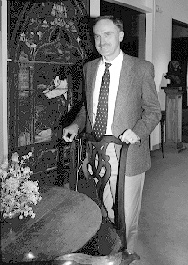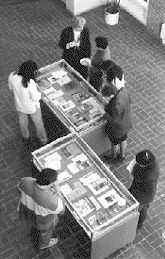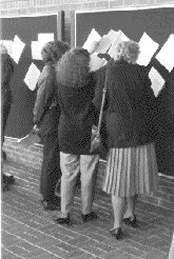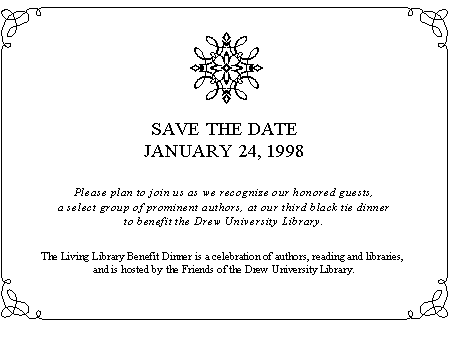Launching the Library Home Page
Internet users and Library supporters, take note. Drew University's home page has a new link: the Library home page, created by the staff and under continual development.
A "home page" is simply a digitized document, or series of related documents, made up of text, graphics, and perhaps multimedia features, which you can view on your computer screen with an Internet browser, such as Netscape. Every home page tells a story, whether it's about a topic, an individual, or an organization.
In this case, the Library home page will give information such as our hours of operation, our borrowing policies, and how to get help from our reference department. You can read about the magnificent stained-glass window over our door; you can identify and contact particular staff members; you can search our online catalog with most browsers; you can follow links to outstanding online resources. And we're just getting started.
The goal of creating a home page was part of the Library's Strategic Plan. This is not surprising, since accessing and utilizing information in any format-be it print, microform, audio, or digital-is central to our mission within the University. Moreover, some Library staff members have been using the University's Internet access for over six years; the online environment is scarcely new to us.
Developing the page has been the charge of the Library's Technology Committee, although it reflects contributions from many departments and individuals. The process of creating the page began by defining its purposes. These included: introducing the Library; providing practical information on Library use; supporting University classes and programs with materials and links chosen by the Library faculty and staff; and archiving in-house publications. "Ultimately," the Committee concluded, "the home page should be a window on the Library."
The next step was brainstorming to turn those goals into specific ideas for content, which we called our "building blocks." We grouped these ideas and, one at a time, began turning them into simple text documents; then we typed in the additional words and symbols called HTML codes. These codes allow people all over the world to display our work on their computers, with a basic consistency of appearance. We used the Library's scanner to digitize pictures and added them to some of the pages. In all our work, we followed the guidelines for the University home page as a whole, which ensure visual consistency and easy navigation throughout the entire site.
You can visit the Library's home page at http://depts.drew.edu/lib/. Your comments are welcome, and as a Visions recipient, you're particularly invited to view previous issues of this newsletter online. Watch for new online issues of Visions and for other new Library links, as we continue development of this exciting new information resource.
Anne L. Noss
Government Documents Assistant
Co-Chair, Library Technology Committee
Treasures of the Library
When Hillary Rodham Clinton addressed the graduating classes of Drew University in May 1996, this Methodist First Lady expressed her appreciation for being invited to "the attic of Methodism." The holdings of the Drew Library, coupled with the Archives of the United Methodist Church also at Drew, form the most comprehensive collection of Methodism anywhere in the world. And this is a truly global collection. Through their missionary efforts, both the American and British churches had worldwide empires. Missionary reports and records were routinely sent to London or New York; in many cases these records have not survived in the country of origin, but the American church records are preserved here at Drew.
Although the Methodist collection does include leather bound first editions of the works of John Wesley, Methodism's founder, and of other early Methodists, George Whitefield and Francis Asbury, to name only two, the collection is not solely religious. The missionary reports contain materials on the history and politics of Asia and Africa in the late nineteenth and early twentieth centuries, a multicultural resource to support studies of race and ethnicity. A truly extraordinary collection of prints, engravings, oil paintings, tintypes, lantern slides, and photographs (some 250,000 photographs from 1890-1930) documents the church's worldwide mission.
A study of the pictorial engravings of camp meetings from 1780 to 1930 yields answers to questions about race, class and gender issues important to the social historian. In the church's efforts to promote its missions activity among its U.S. congregations, the church would send a photographer overseas with the missionary. Until the early twentieth century most of the photographs were "mug shots," but there are some "action" photographs, perhaps of a missionary talking to a group of natives. Most importantly the photographs are not only of Bible study classes. Methodist missionaries played an important role in documenting the Armenian Genocide of World War I. Photographs from the Methodist Archives have been the focus of scholarly inquiry at an international conference addressing the controversies surrounding the Genocide and its historiography.
|
Because of the University's historic connection with the Methodist church, the Library has always had a significant collection of Methodist works. But it was through the hard work and enthusiasm of Drew's Methodist Research Librarian, Kenneth Rowe, that the Drew collections achieved world class status. Ken did his undergraduate work at Drew, received his Bachelor of Divinity from Yale and then was a pastor in Philadelphia for three years. He returned to Drew to do graduate work and also applied for a job with Buildings and Grounds. Fortunately there were no openings, and Ken ended up working part time in the Library, first in the Order department and then for Larry Kline, the Methodist Librarian. "I felt at home here," Ken says of his time as a graduate student working in the Library. Raymond Morris, whom Ken knew at Yale, Arthur Jones, Drew's Library Director, and Larry Kline were looking for bright young people for the library profession, and Ken was persuaded. After attaining the Ph.D. in 1969, Ken received the Master of Library Service degree from Rutgers in 1970 and became Kline's successor as Methodist Librarian. Despite a financially attractive offer from Candler School of Theology in 1971, Ken chose to remain at Drew because he could work with the Methodist collection and teach in the Theological School.
The Methodist collection has grown significantly during Ken's tenure. He has assiduously courted donors and ferreted out hidden collections. He was instrumental in convincing both the Commission on Archives and History of the Methodist Church and the University's administration that the archives should not be languishing in North Carolina, that they formed a natural adjunct to Drew's collections and could be properly stored and accessed here at Drew.
Unlike most attics, Drew's Methodist attic is fully accessible to researchers and has a world class librarian and scholar as its director and advocate.
Linda Connors
Associate Librarian
Reflections
Across the United States, a major effort has been mounted to increase literacy, and many of us have been involved as volunteers in this endeavor. All members of the academic community are expected to know how to read and write, and now face the challenge of becoming computer literate. Libraries and librarians promote the collection and dissemination of information, but it is reading that makes all of it available.
This past January I had the opportunity to read aloud. It was not done under the best of circumstances-it was in a hospital room-and the only thing available to read was a copy of U.S. News & World Report, yet the person to whom I was reading seemed to enjoy it. Knowing the person's interests, I brought with me the next day a copy of David Brinkley: 11 Presidents, 4 Wars, 22 Political Conventions, 1 Moon Landing, 3 Assassinations, 2000 Weeks of News And Other Stuff On Television And 18 Years Of Growing Up in North Carolina.
What a success it was! I was reading to a contemporary of David Brinkley, and he occasionally interrupted a passage and we would discuss it from his viewpoint. In fact, unbeknownst to me, nurses were stopping to listen, and the other patient in the room and his family were also listening. One of the nurses would come in and stay through her breaks. Most of the listeners commented on how soothing they found my reading to be in the middle of all the hospital commotion, which included blaring TVs.
I think that I could have been reading Emily Dickinson or Robert Waller and the listeners' response would have been almost the same as it was to Brinkley's narrative. The appeal to the audience was in listening to a live reader--not a TV or a CD or a cassette. And most important, the listeners could react to the passages with their own life experiences.
The gift of reading aloud was certainly as rewarding to me as it was to the listeners. Most of us stop reading aloud after our children are grown, but what a wonderful gift it can continue to be. Reading aloud opens dialogues and takes us out of our immediate environment. It also slows down the pace of life-there is no such thing as an Evelyn Wood course on speed reading aloud-and it forces us to concentrate. I hope you have the opportunity to discover the impact of reading aloud to an adult, and I know that I will continue to share the gift of reading aloud.
Jean A. Schoenthaler
Director
Upcoming Events
May-September 1997 |
January 24, 1998 |
ONLINE! With Britannica Online
The Britannica Online is a significantly enhanced version of the Encyclopaedia Britannica, 15th edition. Freed from the space restrictions of the print set, many articles are longer and more detailed. There are over 2,100 additional new articles. The online edition is updated continuously, with major revisions several times a year. Britannica Online contains thousands of images: photos, illustrations, maps, flags, equations and other graphic material.
The World Wide Web version of Britannica Online takes advantage of the Netscape browser's ability to use hypertext links embedded in the articles. Clicking the mouse on the Related Internet Resources link at the end of many articles brings you to other relevant sites on the Internet. Click on a cross-reference to go directly to another article in the Britannica Online. Click on an Index link to go to an Index entry, from which you can branch out to one or more of the articles listed. Initials of eminent scholars who write the encyclopedia articles are listed at the ends of articles; click on the initials to see the author's name and description.
Britannica Online has many special databases and features. The New Articles page lists the articles added since the last release of the main database. Britannica Classics links to articles from past editions, such as Sigmund Freud's article on 'Psychoanalysis,' and 'Yosemite' by John Muir. The Britannica Guide to Black History has more than 550 articles covering nearly 400 years of African-American history. Nations of the World lists countries alphabetically, with links to articles covering geographical, cultural and historical aspects, and year-in-review articles. Graphically, you can see flags, maps, and tables of national statistics.
Explore and More leads to a section labeled 'Current Interest.' The events for February 24 - Mar 3, 1997 led this user to the news that Jiang Zemin succeeds Chinese leader Deng Xiaoping, who died recently at age 92. Hotlinks are to articles on Jiang, Deng and Chinese History. The news of Scottish scientists' cloning of a sheep is linked to cloning, genetic engineering and sheep. The re-release of the movie, Star Wars, noted to have reclaimed its title as all-time box-office winner, is linked to articles on George Lucas and Motion Pictures: History: Recent Trends in U.S. Cinema.
Britannica Online is a commercial site to which Drew subscribes. It can be viewed on workstations in the Library and in other academic buildings. Open the URL: http://www.search.eb.com. Campus users who are not yet connected to the LAN can search the text-only version of the database by selecting it from the Library menu on the Campus-Wide Information System. [Note: no longer applicable.]
Ruth Friedman
Reference Librarian
Good Reading
A Civil Action
by Jonathan Harr
A Civil Action (McKay, 1996) is a fast paced, gripping, often disturbing account of a few citizens of Woburn, Massachusetts, who during the 1980s bring suit against two corporate giants, W.R. Grace and Beatrice Foods Co. The suit charged the companies with causing the deaths of children in the town by contaminating the water supply. The author of this courtroom drama is Jonathan Harr, teacher of nonfiction writing at Smith College and former staff writer at the New England Monthly. One of the strengths of the book, which received the National Book Critics Circle Award for Nonfiction in 1995, is the description of an extraordinary cast of characters, especially Jan Schlichtmann, the young, intelligent, brash, and obsessed lawyer representing the plaintiffs. A Civil Action speaks volumes about our legal system, the legal profession, our disregard for the environment, and the human spirit.
Douglas Simon, Professor of Political Science
Consumer Rites: The Buying and Selling of American Holidays
by Leigh Eric Schmidt
Former Drew faculty member, Leigh Eric Schmidt, has written a delightfully informative book (Princeton University Press, 1995). His aim is to explore the manner in which four American holidays (Valentine's Day, Christmas, Easter, and Mother's Day) have evolved from church festivals to occasions where the selling of greeting cards, confections, flowers, and other gifts have become central to the celebration of the day. For each of the days, Schmidt has provided a historical background which traces its development in American culture with considerable attention to the 19th and 20th centuries when each became "consumerized." The book is exceptionally well conceived and written, and includes a generous portion of photographs and illustrations which undergird the lively text. You'll enjoy this masterful study in American social and cultural history!
Charles Yrigoyen, Jr., General Secretary, General Commission on Archives and History
The Autobiography of S.S. McClure
by Willa Cather
Ignored and out-of-print for over three-quarters of a century, this life of muck-raking publisher S.S. McClure (University of Nebraska Press, Lincoln, 1997) exerts a greater fascination in 1997 than it did when published in 1914, because of its narrative voice. Whatever its first readers thought of the story of a poor Irish boy who became rich, infamous, and influential by peddling whatever came to hand, they all agreed that it sounded just like Sam. Samuel McClure, however, was far too impatient to write a manuscript. He talked. The writing was done quietly and effectively by his former managing editor at McClure's Magazine, Willa Cather. Therein lies its interest for Drew's many Cather scholars and readers. For Cather, in capturing her energetic boss's voice, learned to write convincingly in the style of a smart, self-educated, young, male go-getter. In "Tom Outland's Story," a masterpiece novella she inserted in The Professor's House a decade later, that voice was heard again.
Merrill Skaggs, Chairperson and Professor of English
High Tide in Tucson
by Barbara Kingsolver
Believing that most novels are autobiographical, I formed a picture of Barbara Kingsolver, author of The Bean Trees and Pigs in Heaven. In fact, like one of her protagonists, she is an introspective, closet activist from rural Kentucky, who made it in the new west of Tucson, and who works from her gut. However, in this collection of essays (Harper Collins, New York, 1995) Kingsolver says, "I never use my own family and friends as the basis of fictional characters, mainly because I would like them to remain my family and friends. And . . . because I believe the purpose of art is not to photocopy life but distill it, learn from it, improve on it . . ." Her essays show the plot development characteristic of her fiction, and offer a new mental picture of this gifted writer. They address issues that most of us wonder about but can't put into such funny, touching, and wise words. Still, I once met a female friend of Kingsolver's who shows up as a male character in Pigs in Heaven; I guess even the best of writers need real life as a springboard.
Mark Kraai, with Linda Lesniak, Professor of Mathematics
Faculty Exhibit
Continuing an annual tradition, the Drew Library invited members of the Drew community to attend a reception honoring faculty who had published during 1996, and to view the Library's exhibit of their works. On April 3, 1997, faculty members, staff members, and students gathered in the Library lobby to enjoy punch, cookies, and fruit in celebration of Drew faculty members' publications. Faculty members, especially, welcomed the opportunity to meet with their colleagues from other departments and learn about their recent accomplishments.
|
|
Attendees view publications by Drew faculty members |
On display were more than fifty books and journal articles by twenty-nine faculty members. Books filled two glass display cases, and copies of articles hung on three large panels. The works ranged from the broad (The World and Its People) to the specific ("Understory influence of the invasive Norway maple"). They demonstrated the Drew faculty's contributions to the world's knowledge of people ("Leonardo Boff"), places ("El Racismo en Ecuador: Experiencias de los Indios de Clase Media"), words ("The Bilingual Lexicographer's Best Friends"), ideas (Homiletics), and the material world ("The Aspects of Drug Activity and Stereochemistry in Dermatology"). Represented fields included women's studies, religion/theology, economics, ecology, sociology/anthropology, linguistics, psychology, biology, chemistry, the arts, literature, and political science.
The exhibit remained in the Library lobby through the month of April, giving Library users the opportunity to admire book jackets, leaf through articles, and take home a bibliography of the displayed works. Many prospective students visit Drew's campus in April, especially on "Spring Saturday." For visitors, the exhibit offered a sample of Drew's scholarship. For Drew faculty and students, it offered a reminder of the valuable, varied research that underlies and informs this teaching community.
Gifts to the Library
The Rose Memorial Library's holdings of books in Russian have been greatly enlarged over the past year by the donation of the personal library of the late Vasili Semeonovich Yanovsky by his wife, Isabella Yanovsky. The greater part of his collection consists of works by or devoted to the great names of nineteenth century Russian literature: prose, poetry, literary criticism, memoirs, and biographies of writers such as Tolstoy, Dostoevsky and Chekhov.
Dr. Yanovsky was born in Russia in 1906 and left after the Bolshevik Revolution to live in Paris from the 1920s to the 1940s. He studied for the degree of Doctor of Medicine at the Sorbonne, but in addition to science had a lifelong interest in philosophy and religion. He divided his time between the practice of medicine and writing. He was a member of a distinguished group of young Russian emigré poets and writers in Paris, whose activities he chronicled in his memoir Elysian Fields: A Book of Memory (Northern Illinois University Press, 1987).
Dr. Yanovsky was the author of ten books of fiction which ere published in England, France and Italy. His first novel published in the United States was No Man's Time, with a foreword by W.H. Auden. Among his other books are Of Light and Sounding Brass, The Dark Fields of Venus: From a Doctor's Logbook and The Great Transfer.
V.S. Yanovsky died in New York on July 20, 1989. With the help of Associate Professor of Russian Carol Ueland, Coordinator of Collection Development Linda Connors, and Head of Catalog Department Lessie Culmer-Nier, several hundred of his books have already been transferred to the Drew collection, almost doubling the Library's prior holdings of works written in Russian.
Carol Ueland, Associate Professor of Russian
Save the Date!
About Visions
VISIONS
NEWSLETTER OF THE DREW UNIVERSITY LIBRARY
Jean A. Schoenthaler
Drew University Library, Madison, NJ 07940
(973) 408-3322 ascrimge@drew.edu
CONTRIBUTORS: Heather Craven, Eleanor Rawitz, Pamela Snelson
PHOTOGRAPHS: Paula Cameron, Kevin Goldsack
THIS ON-LINE EDITION: Anne L. Noss
A complete online archive of past issues of Visions
can be viewed at:https://uknow.drew.edu/confluence/display/Library/Visions+Library+Newsletter+Archive
VISIONS is a semi-annual publication.
© Drew University Library




